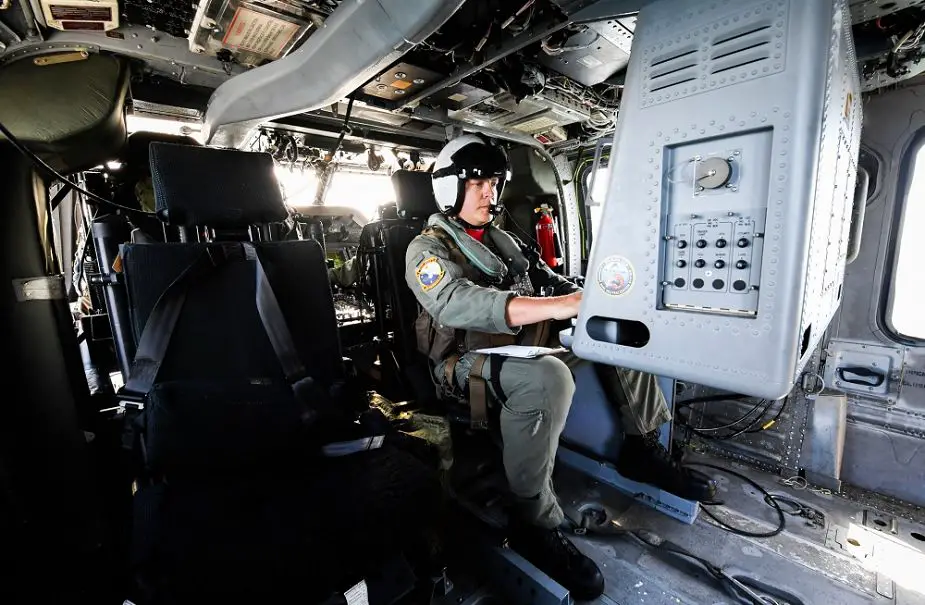U.S. Navy MH-60S Sea Hawk demonstrates its Airborne Laser Mine Detection System (ALMDS) over the Chesapeake Bay on April 29, 2020. The ALMDS uses pulsed laser light and streak tube receivers housed in an external equipment pod to image the entire near-surface volume potentially containing mines.
 An MH-60S Sea Hawk, attached to the Dragon Whales of Helicopter Sea Combat Squadron (HSC) 28, equipped with its Airborne Laser Mine Detection System (ALMDS), flies over the Chesapeake Bay, April 29, 2020. (Picture source U.S. DoD)
An MH-60S Sea Hawk, attached to the Dragon Whales of Helicopter Sea Combat Squadron (HSC) 28, equipped with its Airborne Laser Mine Detection System (ALMDS), flies over the Chesapeake Bay, April 29, 2020. (Picture source U.S. DoD)
An MH-60S Sea Hawk, attached to the Dragon Whales of Helicopter Sea Combat Squadron (HSC) 28 has demonstrated its ability to perform detection of sea mine threats equipped with its Airborne Laser Mine Detection System (ALMDS), over the Chesapeake Bay, April 29, 2020.
The MH-60S Sea Hawk is designed to perform Anti-Surface Warfare, combat support, humanitarian disaster relief, Combat Search and Rescue, aero medical evacuation, SPECWAR and organic Airborne Mine Countermeasures.
The MH-60S is used by the U.S. navy to replace old CH-46 Sea Knight helicopters in 1997. After sea demonstrations by a converted UH-60, the Navy awarded a production contract to Sikorsky for the CH-60S in 1998. The variant first flew on 27 January 2000 and it began flight testing later that year. The CH-60S was redesignated MH-60S in February 2001 to reflect its planned multi-mission use. The MH-60S is based on the UH-60L and has many naval SH-60 features.
The MH-60S Sea Hawk is deployed aboard aircraft carriers, amphibious assault ships, Maritime Sealift Command ships, and fast combat support ships. Its missions include vertical replenishment, medical evacuation, combat search and rescue, anti-surface warfare, maritime interdiction, close air support, intelligence, surveillance and reconnaissance, and special warfare support. The MH-60S is to deploy with the AQS-20A Mine Detection System and an Airborne Laser Mine Detection System (ALMDS) for identifying submerged objects in coastal waters.
 Naval Aircrewman 1st Class Patrick Miller, assigned to the Dragon Whales of Helicopter Sea Combat Squadron (HSC) 28, operates the common console, used for both Airborne Laser Mine Detection System (ALMDS) (pictured) and the Airborne Mine Neutralization System (AMNS), aboard an MH-60S Sea Hawk helicopter. (U.S. DoD)
Naval Aircrewman 1st Class Patrick Miller, assigned to the Dragon Whales of Helicopter Sea Combat Squadron (HSC) 28, operates the common console, used for both Airborne Laser Mine Detection System (ALMDS) (pictured) and the Airborne Mine Neutralization System (AMNS), aboard an MH-60S Sea Hawk helicopter. (U.S. DoD)
In January 2017, the U.S. Navy’s AN/AES-1 Airborne Laser Mine Detection System, designed and manufactured by Northrop Grumman Corporation (NYSE: NOC), has achieved Initial Operational Capability. ALMDS provides rapid wide-area reconnaissance and assessment of mine threats in sea lanes, littoral zones, confined straits, choke points and amphibious areas of operations.
The ALMDS system features several capabilities that make it the first of its kind. It leverages a sensor pod to rapidly sweep the water using laser technology. The sensor pod can also be rapidly installed on a medium-lift helicopter and quickly removed after mission completion. This agile system’s detection speed and accuracy will significantly improve the U.S. Navy’s mine detection capabilities and help ensure the safety of service members around the world.
The ALMDS pod is mechanically attached to the MH-60S with a standard Bomb Rack Unit 14 (BRU-14) mount and electrically via a primary and auxiliary umbilical cable to the operator console. Data is stored on a mass memory unit for post mission analysis. The operator's consol is common to all MH-60S AMCM systems.
ALMDS is capable of day or night operations without stopping to stream out or recover equipment and without towing any equipment in the water. With unteathered operations, it can attain high area search rates. This design uses the forward motion of the aircraft to generate image data negating the requirement for complex scanning mechanisms and ensuring high system reliability. ALMDS also provides accurate target geo-location to support follow on neutralization of the detected mines.



